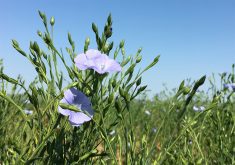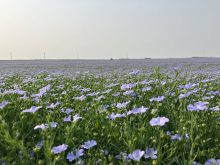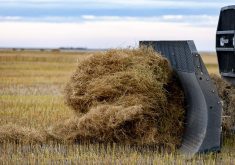2016 yellow and brown flax trials will be conducted in:
The Saskatchewan Flax Development Commission is taking steps to mitigate a significant setback to flax crop breeding: the loss of two of Canada’s three breeding programs.
Agriculture Canada has shut down its program in Morden, Man., and Crop Production Services closed its Northern Adapted Flax Variety Development Project in Saskatoon.
“We have a challenge in our industry on the breeding side of things,” SaskFlax chair Erwin Hanley told delegates attending the association’s annual meeting at CropSphere.
The lone program in Western Canada is Helen Booker’s at the University of Saskatchewan’s Crop Development Centre.
Read Also

Growing garlic by the thousands in Manitoba
Grower holds a planting party day every fall as a crowd gathers to help put 28,000 plants, and sometimes more, into theground
“One breeding program isn’t necessarily a good thing because it’s all on her shoulders now, and we have to rely on her program to provide us with varieties into the future,” Hanley said in an interview after the meeting.
It’s why SaskFlax has been conducting meetings since March with Booker in conjunction with Agriculture Canada, the Flax Council of Canada and Manitoba Flax Growers.
The goal is to devise a long-term strategy for flax breeding and a way to adequately fund the program.
“This certainly will take time to do,” Hanley said.
“It’s not going to happen overnight, but long-term we have to create some stability for the Crop Development Centre and Helen’s program.”
Booker said one of the gaps that the industry needs to address is the impending loss of co-operative trials, which were used to register new varieties.
When there were three breeders, they would work together to run nearly a dozen trials on the Prairies.
However, that co-operative effort will come to an end after this year’s trials as the last material from the now defunct Agriculture Canada and Crop Production Services breeding programs wends its way through the system.
Trials for brown and yellow flax were conducted in three locations in Manitoba, eight sites in Sask-atchewan and one in Quebec.
“Now that we don’t have the other breeding programs, we don’t have any co-operators,” said Booker.
It means she is down to using the three Crop Development Centre sites in Saskatoon, Floral and Melfort as well as the one in Quebec.
Those sights will not generate enough data to meet the merit requirements of the Prairie Recommending Committee for Oil-seeds.
Booker said they need at least four more sites at a cost of about $10,000 per site per year. She would like to see them located in Saskatchewan and run by Agri-ARM, a producer-led research group.
Producers in other provinces could evaluate varieties approved through the Saskatchewan-based breeding program during regional trials.
Booker is also looking for long-term core funding for her flax breeding program to pay for other professional and technical staff.
Don Kerr, president of the Flax Council of Canada, said keeping Booker’s program viable is a top priority for the council.
“We want to make sure that Helen is supported and make sure that she has whatever resources she needs,” he said.
“I think what she is missing primarily is the financial resources to carry on.”
Kerr said Manitoba Flax Growers will be an integral part of the discussions.
Hanley said one of the objectives of the meetings is to provide Booker with a good idea of what breeding advancements growers want to see, such as a determinant plant that stops growing and dries down at harvest time.
“That would help immensely in terms of straw management and being able to harvest it, simply chopping it and putting the straw through the combine instead of dropping it and having to burn it,” he said.
SaskFlax is in a much better financial position to fund Booker’s program because of a rebound in flax acres in the province.
Saskatchewan growers planted 1.4 million acres of the crop in 2015, up from a post-Triffid low of 535,000 acres in 2011.
That has boosted levy income and resulted in a surplus over expenses of $626,526 in 2014 and $475,385 in 2015.
The commission is saving the excess to help fund the new research and development strategy once it is finalized.
“We’re going to have to spend a large part of our money on research, and breeding is certainly on top of that list,” said Hanley.
Flax trial regions
2016 yellow and brown flax trials will be conducted in:
- Zone 1 (black soil zone): Morden, Man., Brandon, Indian Head, Sask., Portage la Prairie, Man.
- Zone 2 (brown and dark brown soil zone): Saskatoon, Floral, Sask., Regina, Moose Jaw, Sask.
- Zone 3 (black and grey soil zone): Melfort, Sask., Rosthern, Sask., North Battleford, Sask.
- Outside the Prairie region: Quebec


















